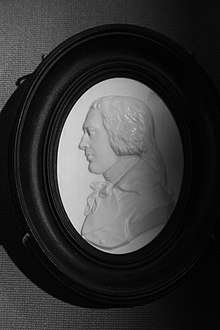Basil William Douglas
Basil William Douglas, Lord Daer FRSE (1763-1794) was a short-lived influential Scottish nobleman of the 18th century. He was a politician and agricultural improver. He was an advocate for parliamentary reform and supporter of the "Friends of the People". He is one of the small group of people whom Robert Burns wrote poetry upon.

Life
He was the second son of Helen Hamilton and Dunbar Douglas, 4th Earl of Selkirk. Despite the death of his parents first son in infancy, Douglas did not become Earl as he died before his father. He was educated at the University of Edinburgh and while studying lodged with Dugald Stewart.[1]
In 1785 (soon after its inception in 1783) he was elected a Fellow of the Royal Society of Edinburgh. His proposers were Dugald Stewart, James Gregory, and John Walker.[2]
In 1786 he travelled with Dugald Stewart to his country house at Catrine in Ayrshire, and there, on 23 October, he was introduced to Robert Burns, Burns' first meeting with nobility.[1] Burns wrote of this event:
"Nae honest, worthy man need care,
To meet with noble, youthful Daer
For he but meets a brother"
He died in Ivybridge, Devon, and is buried in Exeter Cathedral.[3] On his death the title of Lord Daer passed to his younger brother Thomas Douglas who soon became the 5th Earl of Selkirk.
Artistic recognition
Lord Daer was portrayed in his meeting with Robert Burns.[4]
References
- "Robert Burns Country: The Burns Encyclopedia: Douglas-Hamilton, Basil William, Lord Daer (1764 — 94)". www.robertburns.org. Retrieved 6 July 2019.
- Biographical Index of Former Fellows of the Royal Society of Edinburgh 1783–2002 (PDF). The Royal Society of Edinburgh. July 2006. ISBN 0 902 198 84 X.
- "Discover church monuments – Church Monuments Society". churchmonumentssociety.org. Retrieved 6 July 2019.
- "Engraving 'Burns interview with Lord Daer' - Robert Burns Birthplace Museum". www.burnsmuseum.org.uk. Retrieved 6 July 2019.